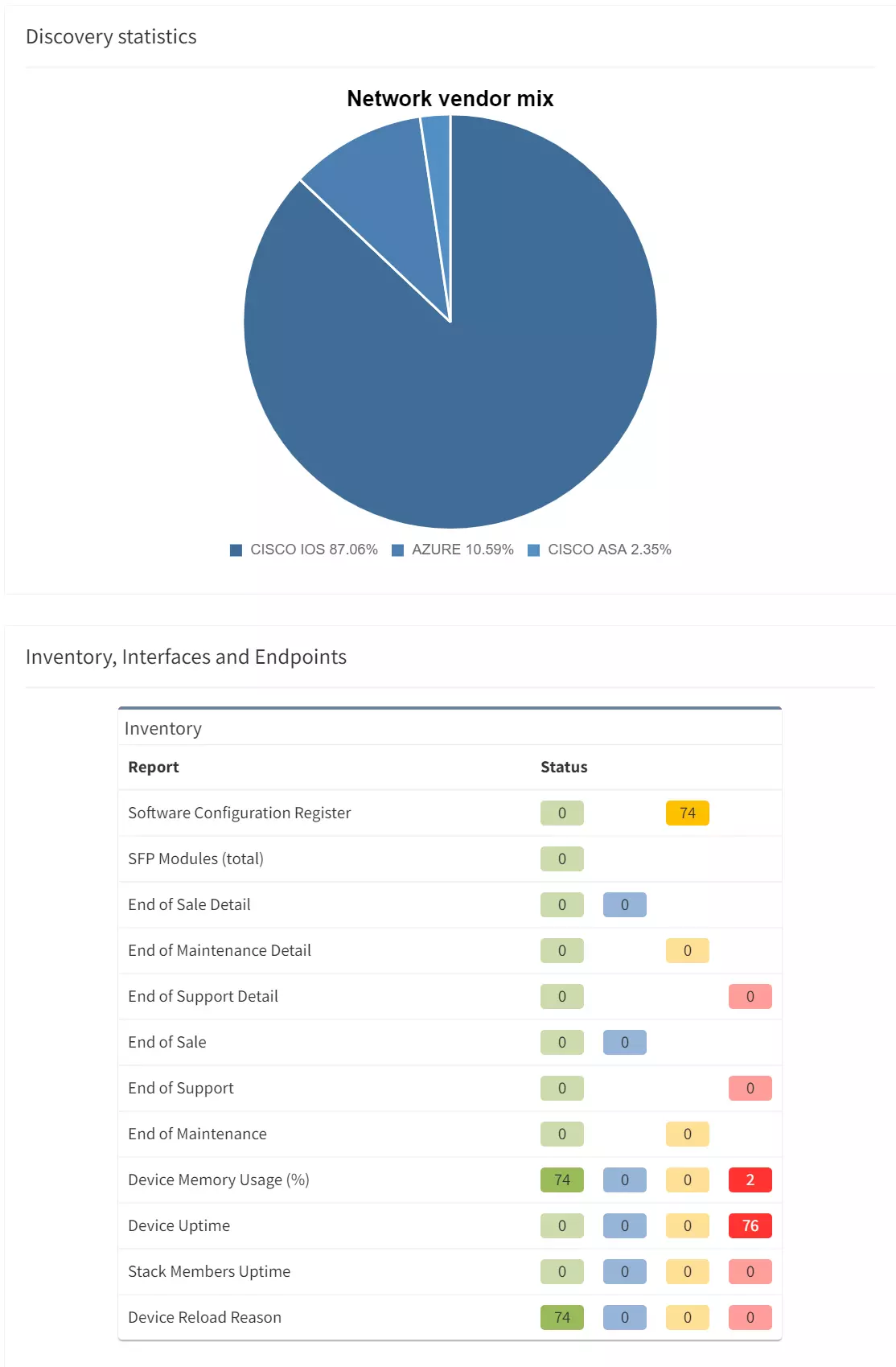

After a few weeks of intensive development, there is a new version of the IP Fabric, that improves the platform's scalability and resolves a number of bugs. This minor bugfix release follows a major 3.3 version completed just 2 weeks ago.
The improvements modified the way how network change calculations are performed. Please don't forget to unload/load any older snapshots after upgrading to 3.3.1 or you will get false-positive results in network changes.
The main improvements of the 3.3.1 are around the performance of snapshot operations in large scale networks. Network model code optimizations speeded up both the collection and representation of the data. Major improvement was done for the "finish" job, which calculates reports and changes. We've seen improvements by over 20% in some of the networks, and this is the major addition in version 3.3.1.
From the mildly updated version, the IP Fabric users are allowed to use an empty username for discovery via Telnet. This is needed for some of the legacy networks when user-less authentication is still in place.
Another tiny switch now allows to set an expiration date to any presented password in the list. It's a great help for large deployments with a long password list in use where some of the passwords may be issued only temporarily.

Moreover, IP Fabric now remembers the protocol used for discovery (SSH/Telnet) and will prefer the protocol for the next network snapshot.
The Techsupport file is a very important part of the IP Fabric solution that streamlines communication between the Customer and the IPF development team. The file itself can be generated in the platform which creates an encrypted version/image of the client's IPF environment including all information for successful troubleshooting of any potential issues.
We have updated the user experience and every new triggered TechSupport generation will follow a new process. As a result, the user will not have to wait for the download link to appear, but rather mind the process in the background. The file will be available when ready in the notification area.

With new code updates, the processing of small snapshots is now much faster. Small snapshots are mostly used for collecting updated information for specific application paths or small groups of devices.
In the previous version of the IP Fabric in the Advanced settings, the platform automatically produced results for RegEx bases Site Separation automatically. As this solution was intuitive, it lacked scalability and could have slowed down the page. The Site Separation results are now provided on-demand with a new button.

We have updated classification for CDP/LLDP endpoints. As a result, the unmanaged endpoints, that are classified as endpoints (servers, hosts), have no protocol links to the transit in diagrams anymore.

After the very first iteration of the new vendors' support (Enterasys, Mikrotik), we have received multiple unexpected outputs that had to be understood. Apart from that, we have updated several commands for Arista, Aruba switches, F5 or Juniper.
Big thanks to our supporting customers, who are constantly helping us to improve the platform. Full details of the release could be found in our Release Notes.
If you have found this article resourceful, please follow our company’s LinkedIn or Blog, where there will be more content emerging. Furthermore, if you would like to test our platform to evaluate how it can assist you in managing your network more effectively, please let us know through www.ipfabric.io.
After a few weeks of intensive development, there is a new version of the IP Fabric, that improves the platform's scalability and resolves a number of bugs. This minor bugfix release follows a major 3.3 version completed just 2 weeks ago.
The improvements modified the way how network change calculations are performed. Please don't forget to unload/load any older snapshots after upgrading to 3.3.1 or you will get false-positive results in network changes.
The main improvements of the 3.3.1 are around the performance of snapshot operations in large scale networks. Network model code optimizations speeded up both the collection and representation of the data. Major improvement was done for the "finish" job, which calculates reports and changes. We've seen improvements by over 20% in some of the networks, and this is the major addition in version 3.3.1.
From the mildly updated version, the IP Fabric users are allowed to use an empty username for discovery via Telnet. This is needed for some of the legacy networks when user-less authentication is still in place.
Another tiny switch now allows to set an expiration date to any presented password in the list. It's a great help for large deployments with a long password list in use where some of the passwords may be issued only temporarily.

Moreover, IP Fabric now remembers the protocol used for discovery (SSH/Telnet) and will prefer the protocol for the next network snapshot.
The Techsupport file is a very important part of the IP Fabric solution that streamlines communication between the Customer and the IPF development team. The file itself can be generated in the platform which creates an encrypted version/image of the client's IPF environment including all information for successful troubleshooting of any potential issues.
We have updated the user experience and every new triggered TechSupport generation will follow a new process. As a result, the user will not have to wait for the download link to appear, but rather mind the process in the background. The file will be available when ready in the notification area.

With new code updates, the processing of small snapshots is now much faster. Small snapshots are mostly used for collecting updated information for specific application paths or small groups of devices.
In the previous version of the IP Fabric in the Advanced settings, the platform automatically produced results for RegEx bases Site Separation automatically. As this solution was intuitive, it lacked scalability and could have slowed down the page. The Site Separation results are now provided on-demand with a new button.

We have updated classification for CDP/LLDP endpoints. As a result, the unmanaged endpoints, that are classified as endpoints (servers, hosts), have no protocol links to the transit in diagrams anymore.

After the very first iteration of the new vendors' support (Enterasys, Mikrotik), we have received multiple unexpected outputs that had to be understood. Apart from that, we have updated several commands for Arista, Aruba switches, F5 or Juniper.
Big thanks to our supporting customers, who are constantly helping us to improve the platform. Full details of the release could be found in our Release Notes.
If you have found this article resourceful, please follow our company’s LinkedIn or Blog, where there will be more content emerging. Furthermore, if you would like to test our platform to evaluate how it can assist you in managing your network more effectively, please let us know through www.ipfabric.io.




